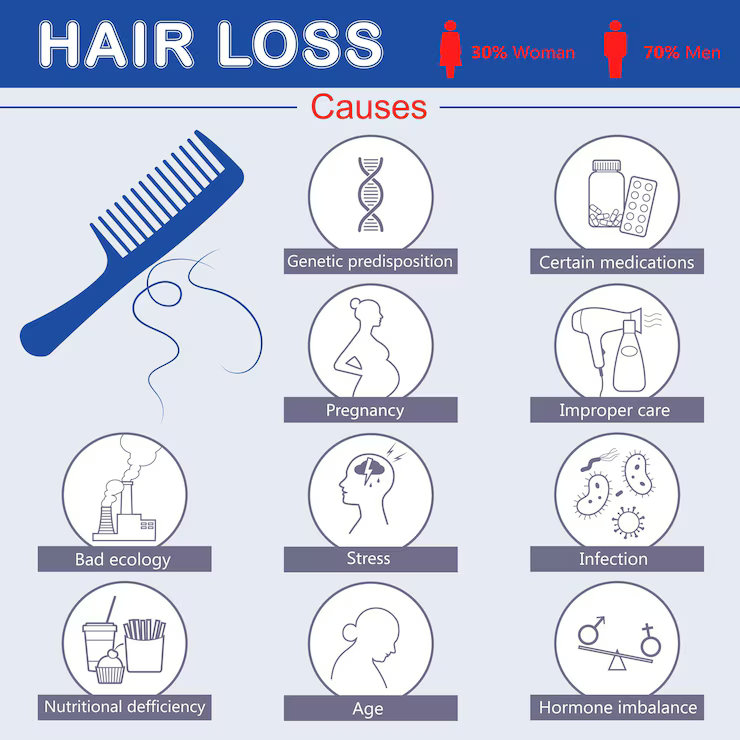Hair transplant statistics


Hair Loss Explained: Causes, Prevention Tips & Treatment Options
Hair loss, also known as alopecia, is a common condition that can affect individuals of all ages and genders. It may be temporary or permanent and can occur on its own or as a symptom of an underlying health issue. While not physically harmful in most cases, hair loss often has a significant emotional impact, especially among women, and can affect personal confidence, relationships, and mental health.
Thankfully, there are several effective ways to diagnose, prevent, and treat hair loss—once the root cause is identified. This is particularly important for women, as the causes and patterns of female hair loss can be harder to detect and treat accurately.
Hair Transplant Treatment : Everything You Need to Know
Hair transplants have become one of the most sought-after treatments for conditions like male pattern baldness. The procedure involves extracting hair follicles from donor areas (typically the sides or back of the head) and transplanting them to thinning or balding regions such as the hairline, crown, beard, or eyebrows.
In 2022, over 735,000 hair restoration surgeries were performed globally (ISHRS, 2022). The rising popularity stems from the effectiveness of hair transplants as a long-term solution for hair loss and the influence of appearance-driven culture.
Hair restoration is becoming more precise, patient-focused, and technologically advanced—with global trends indicating a clear preference for techniques offering natural results, reduced downtime, and improved surgical outcomes.
Hair Transplant Predictions: What Will Surgeries Look Like?
Although some aspects of the global hair transplant market remain unpredictable, the overall trajectory of surgical hair restoration is set to maintain its current momentum. By 2030, a noticeable shift is expected toward procedures that extract individual hair follicles—specifically FUE and DHI—while traditional strip treatment methods are likely to see a steady decline.
- FUE (Follicular Unit Extraction) – FUE is projected to account for approximately 70% of all hair transplant procedures by 2030. This technique is widely preferred due to its minimally invasive approach, suitability for most patients, and consistent availability across global clinics.
- DHI (Direct Hair Implantation) – The adoption of DHI is anticipated to grow significantly, reaching about 15% of all procedures by 2030. As more surgeons become proficient in using Choi implanter pens and as technological tools evolve, DHI is set to become a major component of the hair restoration landscape.

What Reasons Do People Get Hair Transplants?
People choose to undergo hair transplant treatment for a variety of personal, professional, and psychological reasons. While each individual’s motivation is unique, several common factors explain the rising popularity of this procedure:
- 1. To Boost Confidence and Appearance According to the International Society of Hair Restoration Surgery (ISHRS), more than 60% of patients worldwide say their main reason for getting a hair transplant is to improve their appearance and self-esteem. Hair loss—especially conditions like male and female pattern baldness—can have a major emotional impact, often leading individuals to seek surgery to restore a youthful, natural look and feel more confident in social situations.
- 2. For Professional or Career Advancement Roughly 34.7% of patients say they underwent the procedure to enhance their professional image. In industries where looks matter—such as media, entertainment, sales, and hospitality—maintaining a vibrant, healthy appearance can positively affect job prospects and workplace confidence.
- 3. For Romantic and Social Reasons Around 37% of individuals report that they chose to have a transplant to improve their romantic life or social interactions. At our clinic, we frequently see patients opting for hair restoration in the lead-up to major life events like weddings, engagements, or reunions—moments when they want to feel their absolute best.
- 4. To Improve Psychological Wellbeing Hair loss is linked to issues like low self-esteem, anxiety, and depression. According to research published in the Journal of Clinical and Aesthetic Dermatology, patients often experience a significant improvement in overall wellbeing after hair transplant surgery. Many report a noticeable lift in their mood, social confidence, and daily quality of life.
Hair Transplant Statistics: Gender, Age & Success Rates
What Percentage of Men and Women Get Hair Transplants?
Globally, 87.3% of hair transplant patients are men, while only 12.7% are women. Most procedures are aimed at treating male pattern baldness, which is typically permanent and progressive.
Women are more likely to experience temporary hair loss, so they often turn to non-surgical options like PRP, Minoxidil, or red light therapy. Among female patients, eyebrow transplants tend to be more popular than scalp procedures.
What Age Do People Get Hair Transplants?
Hair transplants are most common between the ages of 25 and 50.
Men: 30–39 (29.3%) is the most common age group, followed by 40–49 (27.9%) and 20–29 (18.1%).
Women: Highest in the 40–49 range (28%), then 30–39 (26.8%). Only 16.7% of women under 30 opt for treatment .
This aligns with the natural progression of hair loss: men typically experience androgenetic alopecia earlier, while women often see hair thinning post-menopause.
